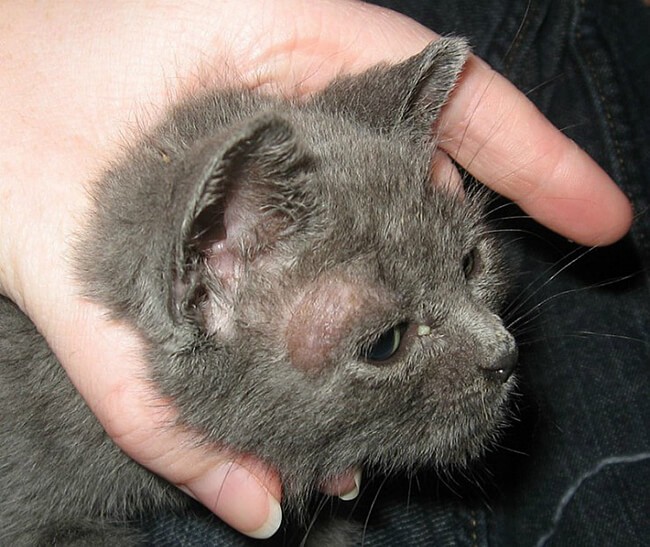Cat skin fungus is both uncomfortable and unhygienic in cats, especially it can cause serious, life-threatening complications for cats in some cases. Cats can get a fungal infection in three ways: By ingestion, by inhalation, or by skin contact. So what to do if the cat has a fungal skin infection? How to treat a cat with tinea capitis? The following article will help you answer this problem.

Is a cat with tinea versicolor dangerous?
Cats with fungal infections can develop other complications, such as:
- Weight loss.
- Fever.
- Shortness of breath.
- Skin discomfort.
- Cysts under the skin.
- Eye problems.
- Bleeding in the nose.
- Loss of appetite.
- Sneezing.
- Swelling under the bridge of the nose.
- Septicemia.
- Lung infection.
- Bladder infection.
- Symptom:
- Runny nose.
- Shortness of breath.
- Make a sound when breathing.
- Swelling on one side of the face.
- Pneumonia.
- Seizures in severe fungal infections.
- Cat is moody, vomiting, diarrhea.
Common fungal skin diseases in cats and how to treat them
1. Common fungal spores that can infect humans
A common and long-lasting disease caused by the fungus Sporothrix. They enter the body through wounds in the skin through contact where the fungal infection is located. This disease can be transmitted to humans and the feces of infected pets will also harbor this fungus.
Sporotrichosis is more common in cats than in other species and the disease is difficult to detect in the beginning. A prolonged infection can lead to fever, fatigue, and becoming sad. More dangerously, the infection can spread from the original site to the bones, lungs, liver, spleen, testicles, gastrointestinal tract, or central nervous system.
Diagnostic: Sporothrix mycosis is diagnosed by tissue culture and subsequent identification.
Treatment: Long-term treatment with antifungal drugs (continuous 3 to 4 weeks) is possible. Because the disease can be transmitted from pets to people, strict hygiene must be observed when a pet is suspected or diagnosed with fungal infection.
2. Aspergillosis
Aspergillosis often infects pets through a weakened immune system or after other diseases.
Treatment:
Diagnostic: A veterinarian's assistance is required to determine the type of fungal infection and prescribe appropriate treatment.
Treatment: Common cutaneous aspergillosis can be treated with oral antifungal medications. However, the treatment of severe aspergillosis requires a more intensive nose.
3. Candidiasis
This rare type of fungal infection can affect cats of all ages and breeds, even when the conditions are not favorable. Candidiasis infection can take place in a specific part of the body (locally), or it can invade the entire body (systemic) to cause extreme discomfort.
Diagnostic:
The way candida symptoms manifest depends largely on where the infection occurs. Accompanying symptoms:
- Candidiasis Ear infection: Trembling + Constant scratching.
- Oral candidiasis: Drooling.
- Candidiasis Bladder: Cystitis + Fever.
Treatment: Treatment includes improving the immune system. Once a diagnosis is made, your veterinarian will decide how to treat your cat's fungal infection with antibiotics, topical ointments, and fungicidal shampoos.
4. Cryptococcosis Nấm
Nấm Cryptococcosis là một bệnh nấm có thể ảnh hưởng đến đường hô hấp ( khoang mũi), hệ thần kinh trung ương, mắt và da (đặc biệt là mặt và cổ) của mèo. Loại nấm này có trong đất và phân chim…, đặc biệt là trong phân chim bồ câu, lây truyền cho mèo do hít phải bào tử hoặc nhiễm bẩn vết thương.
Diagnostic:
Cryptococcosis is quite common in cats, causing signs of infection of the nasal cavity being the most common. Signs include: sneezing; nosebleeds, clear or pus, and hard swelling under the skin and on the bridge of the nose. Areas with small bumps and nodules that can affect the skin; soft (liquid-filled) or firm feeling.
These areas are at risk of ulceration and forming a rough surface. Neurological signs associated with cryptococcosis affecting the central nervous system include depression, mood swings, convulsions, circulation, mild paralysis, and blindness.
Treatment: Cats with Cryptococcosis need to be taken to the vet for treatment.
5. Dematiaceae fungal infections
Infections caused by fungi of the family Dematiaceae can be caused by fungal infection at the site of an open injury.
Diagnostic: The infection is limited to the skin and underneath the skin, with large masses slowly beneath the skin found on the toes, ears, face, and nasal mucosa. In rare cases it can affect the central nervous system. Infected nodules may ulcerate and have drainage channels.
Treatment: Fungal infections are treatable with antifungal ointments, antibiotics, and bath oils.
Here is some information about Causes of cat skin fungus and how to treat it that we want to share with you. Wish you have healthy and lovely cats. If you need to know more about other ways to take care of cats, contact http://vanchuyenchomeo.com/ for advice.